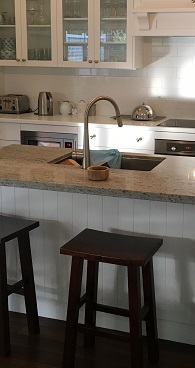Learn to Renovate Buildings
Learn to understand building methods and techniques, and how to plan and manage a building renovation property - both exterior and interior.
In this certificate, you'll learn the basics of modernisation and materials, and gather the skills to plan for and undertake renovation of an existing space.

Course Duration: 600 hours
Course Structure
This certificate is comprised of six modules, five core and one elective.
Core Modules:
Students complete each of the following.
Elective Modules:
Select one of the following electives.
Enrol Today
Ready to get started? Click on the orange enrol now button.
Have questions? Click here to email our course counsellors.
Buildings Deteriorate
Most parts of a building will over time, deteriorate. More exposed areas such as exterior walls or roofs are generally better protected from the ravages of the environment; but they are also more vulnerable.
How Are Roofs Repaired?
Over time, roofs can develop leaks if tiles or slates become damaged or dislodged, if flashings are dislodged or pierced, or if other deterioration occurs. Some parts of a roof are more prone to developing leaks than others (e.g. flashings around a chimney, skylight or ridge gutter, joins on bitumen sheets or flashings).
Roofs may be more vulnerable to damage when work is done on a roof (e.g. installing a smoke stack, air vent, skylight, extending a roof over a building extension, installing a roof garden).
Slates may become broken or dislodged due to wear from weather, debris falling on the roof or expansion and contraction of roofing timbers and materials.
Metal roofing can dislodge or leak easily if not fixed properly; and for this reason, it is always preferable to have this type of roof fixed by a licensed, experienced roofer.
Replacing Tiles
For plain tiles which have been nailed it is necessary to cut the nails to release the tile. If they are on a course which hasn't been nailed then it should be quite straightforward to lift the tile so that the nibs are free of the batten. Remove and slide in a new tile.
For single lap and other interlocking tiles, you can use wooden wedges slid beneath the outer edges of the two tiles of the course above which overlap the tile you wish to replace. You can then lift the tile to be replaced until it becomes unhooked from the batten. Slot the new tile into position and remove the wedges.
Repairing Flashings
Roof flashings are used to direct water away from areas where it could penetrate the roof. They serve like a damp-proof course. Flashings are found where walls meet sections of roof and also where anything enters or exits the roof, e.g. pipes and chimneys, and around features such as skylights.
Usually flashing is made from sheet metal such as lead, stainless steel or copper. There are cheaper alternatives like plastic though it is not as durable. If the flashing has become damaged or loose then water may enter roofs and walls.
Flashing around a skylight or wooden dormer window is likely to be laid in continuous strips, with one piece around the top, one at each side, and one across the bottom of the opening (known as the apron flashing). The strips fit beneath the roofing materials. Skylights have to sit proud of the roof so that there is sufficient room to install flashing up the sides of the window frame.
Flashing around a brick chimney stack or where a brick wall meets a roof is often stepped. That is, the flashing down each sloping side of the stack is stepped into the brick courses to maintain a damp proof seal. The flashing is inserted 25mm into the mortar course, secured with lead wedges and pointed. When slates or single lap tiles are the roof covering the flashing is used in conjunction with lead soakers.
Soakers are fitted first, before the flashing. Soakers are like metal slates or tiles if you like. They are L-shaped in cross section with a 75mm lip which butts up against the brickwork. The length of the soaker is the lap plus the gauge and it is a minimum of 100mm wide. The soaker can be nailed through the slate or tile hole of the slate it sits on or it can be cut longer to allow a 25mm nib to be folded on the end which hooks over the batten. In effect the bottom slate or tile, i.e. the eaves row or starter row, is laid down first and then the first soaker is positioned on top of it and secured. Then the first row tile is laid onto it, followed by the next soaker and so on alternating between tile and soaker all the way up until complete.
Temporary Roofs
Roofs sometimes need to be replaced in part or fully, and while that work is happening, the building below needs to be temporarily protected. This may be done with tarpaulins or even plastic sheets – but very firmly attached. Always plan well ahead to minimise the time that any temporary roof cover is required.